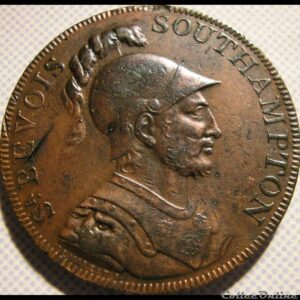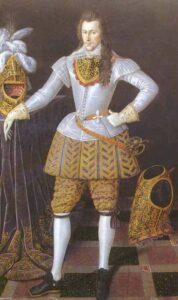The earldom of Southampton lasted for just over a hundred years, from its first creation in 1537 until the line died out in 1667, However the idea of Southampton being the seat of an important earldom dates back much earlier and is linked to French Romances around the time of the Crusades.
The mythical knight Sir Bevis of Hampton was styled the son of ‘Guy, Erle of Southampton’, William Camden in his history refers to Bevis as a Saxon who tried to stem the Norman tide, making a stand at the battle of Cardiff in Wales. Later versions of the tale show Bevis vanquishing the Italian merchant colony in London and he was a popular figure when antagonism to the foreigner was at its height in 1456/7. By the fifteenth century the town of Southampton, like other towns in England, was concerned with defining their physical space, creating symbols of civic government and raising the profile and influence of their towns. As well as developing political ceremony, patronage and regalia this included looking back into history to discover a suitable founder – a Saxon king or Saint, or other suitable heroes – Southampton had a ready-made hero in the story of Bevis of Hamtun, and with the introduction of printed texts and illustrations the story became more accessible both as a text and as image.

Symbols taken from the stories decorated the gates and civic buildings of the town: lions, dragons, unicorns as well as oak panel paintings of Bevis and his squire Ascupart which were hung on the Bargate, the main entry point to the town. The text was also studied in schools as a template for knightly behaviour, and kings like Henry V had tapestries illustrating the story, it was such a well-known tale that when the writer George Peele likened Henry Wriothesley, third earl of Southampton to Bevis after his appearance at a court tournament in 1595, everyone knew the knightly attributes and struggles that Bevis had overcome. He had had his patrimony stolen from him, was sent into exile, suffered many travails before returning triumphant to reclaim his inheritance.

As for the sixteenth century earls, they were perhaps a little less noble than Bevis. The title was first created in 1537 for one of Henry VIII’s new men, William Fitzwilliam. When Fitzwilliam died without issue the title was dormant for a few years before the second creation in the person of another of Henry VIII non-aristocratic henchmen, Thomas Wriothesley who only obtained the title at the close of Henry’s reign in 1547.
Although Thomas Wriothesley had been an enforcer of the Henrician Reformation and had benefited from the appropriation of church lands, particularly the abbey of Beaulieu, he was, like his royal master, quite conservative at heart. This along with the influence of his wife saw his son Henry, the second earl brought up as a Catholic. Henry was lucky to escape with his life from his plotting and probably his early death saved him from a worse fate. His marriage to Mary Browne had not been successful and the couple lived apart, and after the death of the second earl his heir the more famous third earl was brought up in the household of Lord Burghley, chief advisor to Elizabeth I.

Henry, third earl of Southampton was as reckless as his father, marrying Elizabeth Vernon in 1598 without the consent of the Queen and then throwing his lot in with the earl of Essex who led a rebellion against Elizabeth I towards the end of her reign in 1601. Essex was beheaded, and Southampton languished in the Tower until released by James I.
In looking at the interactions between the earls and the town of Southampton, this is usually illustrated by the exchange of gifts, the traditional present of wine but also more exotic fair such as marmalade, sugar, lemons and oranges. In return the mayors of Southampton would receive a gift of bucks from the earl’s estate and even on one occasion enjoying a hunting trip the second earl laid on at Titchfield. The town would look to the earls to use their influence at court on the town’s behalf. The earls also had a property within the town, Bull Hall, which stood on Bugle Street (previously Bull Street), when the third earl fell from favour that property was seized by the crown. The Court Leet records show however that the Queen did not attend the court, which was held on Southampton Common, as householders were expected to do.
Once released from captivity the third earl turned his attention to the development of colonies in the new world particularly the development of the area known as Virginia and the first successful colony at James Town. This promotion also helped the port of Southampton which became a key port for early migrants to the New World, including the Mayflower pilgrims.
The third earl and his eldest son perished whilst on campaign in the Low Countries, his surviving son succeeded to the title but when he died without a male heir the title died with him.
Lingering links between the earls, mythical and real, survive in the writing of William Shakespeare who dedicated verse to the third early and referenced the story of Bevis in King Lear, and took themes from the story to be used in Hamlet, and was inspired by a shipwrecked group of colonists to write The Tempest. It is likely that Shakespeare visited the town in 1593/4 as part of a joint tour being made the by Admirals & Chamberlains men whose licence is recorded in town records. He was also aware of the town’s history to include a pivotal scene in his play Henry V about the Southampton Plot. Local oral history also claims that Romeo & Juliet was premiered at the earl’s private playhouse at Titchfield.

Further Information:
Cheryl Butler (ed) The Book of Fines: The Annual Accounts of the Mayors of Southampton 1488-1594, Southampton Records Series 3 Vols
Lynn Forest Hill (translator): Bevis of Hampton
F J C & D M Hearnshaw: Court Leet Records 1578-1602 Vol I part II, Southampton Record Society

Author: Dr Cheryl Butler
Bio: Dr Cheryl Butler is a Fellow of the Royal Historical Society, Fellow of the Royal Society of Arts, and Honorary Fellow of the University of Winchester and is a member of the editorial board for the Southampton Records Series and the Hampshire Papers. She has published a number of books and papers which have drawn upon the archives from the Southampton Records office and Hampshire Archives including three Southampton Records Series volumes on the Southampton Mayors Book of Fines; the oral history of Itchen Ferry Village We only wore shoes on Sunday; a book on Tudor Southampton: Rioters, Revellers & Reformers; Jane Austen & Southampton Spa and Powder, Prisoners & Paintings – The Story of God’s House Tower. She has organised several large award winning community heritage projects including The Diaper Heritage Project; Los Ninos, the story of the Basque Children Refugees; Tudor Revels; The Stinking Fish of Southampton, Jane Austen 200. She is passionate about using archives to inform creative projects and is writer director of the site specific Sarah Siddons Fan Club Theatre Company. She is on the National Training Committee for the British Guild of Tourist Guides and chair of the Diaper Heritage Association one of the largest single name genealogical study organisations. Winner of the British Association of Local History personal achievement award in 2014 and the City of Southampton award in 2018 for services to heritage. She has spoken at numerous national and international conferences raising the profile of Southampton and its rich archives and history. She runs a volunteer palaeography group which transcribes sixteenth century documents and is a published novelist, her novel, The Theatre of the World is set in Elizabethan England, based on original material from Southampton town archives.
Her latest books:
St Mary-over-the-Water; The story of Pear Tree Church 2020
The Remembrance Books of Robert Knaplock 1575 and John Jackson 2021
Telling Other hiStories: early black history in Southampton c1500-1900 2021

